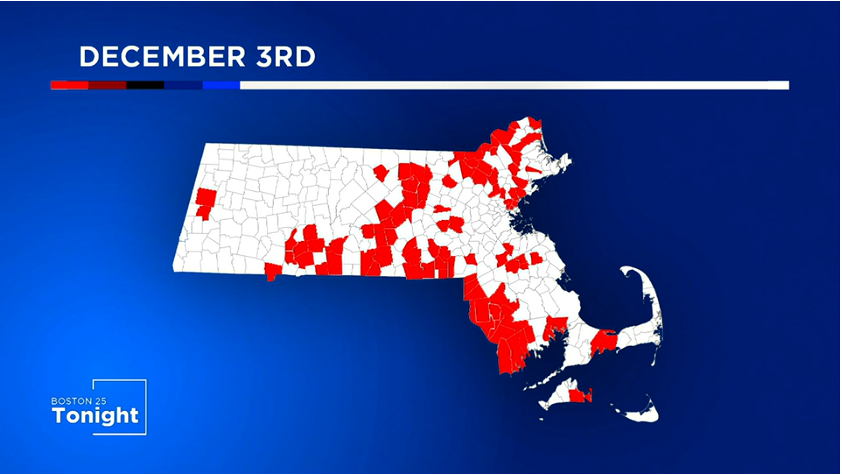This week, the Department of Public Health released their weekly dashboard which classified 97 Massachusetts towns and cities as “red zones.” That number is about eight times higher compared to just one month ago. Michael Gibson, MD (Interventional Cardiology, BIDMC) explained, “when one person gets it, they give it to two, then they give it to four, we are seeing the exponential growth when people run into each other, some of whom are a symptomatic carriers.” Gibson also notes that social economics is a factor in the rise of COVID-19 cases.
Boston 25 News – December 3, 2020
Why, week after week, do certain communities remain at high-risk for COVID-19?

BOSTON — For months now, the state has been releasing a weekly dashboard outlining the risk for COVID-19 in each city and town in Massachusetts.
Communities considered “red zones” are at higher risk for COVID-19 infection, while those in “yellow zones” are at moderate risk and cities and towns in either green or gray zones are considered safer from the virus – but that doesn’t mean its fine to walk around without a mask in those communities.
Since the pandemic began, Boston 25 crews has been reporting from the red zone for months now. On Thursday, the state saw nearly 6,500 new cases – a record high for the commonwealth.
Brockton residents are urging each other to take this virus seriously and help keep each other safe.
“I think there are a lot of people that don’t care or practice safe mask wearing or hand washing,” said Karen Brennan, a nurse.
Boston 25 spoke to Brennan about why areas like Brockton remain in the red zone, month after month.
“I lost my dad a month ago to COVID-19,” said Brennan.
Brennan says her dad, John Nugent, was a healthy 93-year-old man when he suddenly suffered a stroke. She says her dad contracted COVID-19 at an out-of-state rehab facility.
“People are suffering and are not doing well,” said Brennan. “My dad died and I couldn’t be with him.”
This week, the Department of Public Health released their weekly dashboard which classified 97 Massachusetts towns and cities as “red zones.” That number is about eight times higher compared to just one month ago.
“When one person gets it, they give it to two, then they give it to four, we are seeing the exponential growth when people run into each other, some of whom are a symptomatic carriers,” said Dr. Michael Gibson, a cardiologist at Beth Israel Deaconess Medical Center.
Health officials estimate there are more than 49,000 active cases in the state currently.
“Once you’re in the red zone, it’s really hard to crawl out,” said Gibson.
“A lot of people see it, they’re educated, but they choose not to believe the education that’s out there,” said Orlando Ortiz, of Brockton. “Wear the masks, wash their hands, stay away from each other for a little while.”
Gibson says that part of the problem also relies on social economics, where people in some of these areas are essential workers and have no choice but to go to work and risk exposing themselves just to get by financially and may not have the opportunity to socially distance from others.

